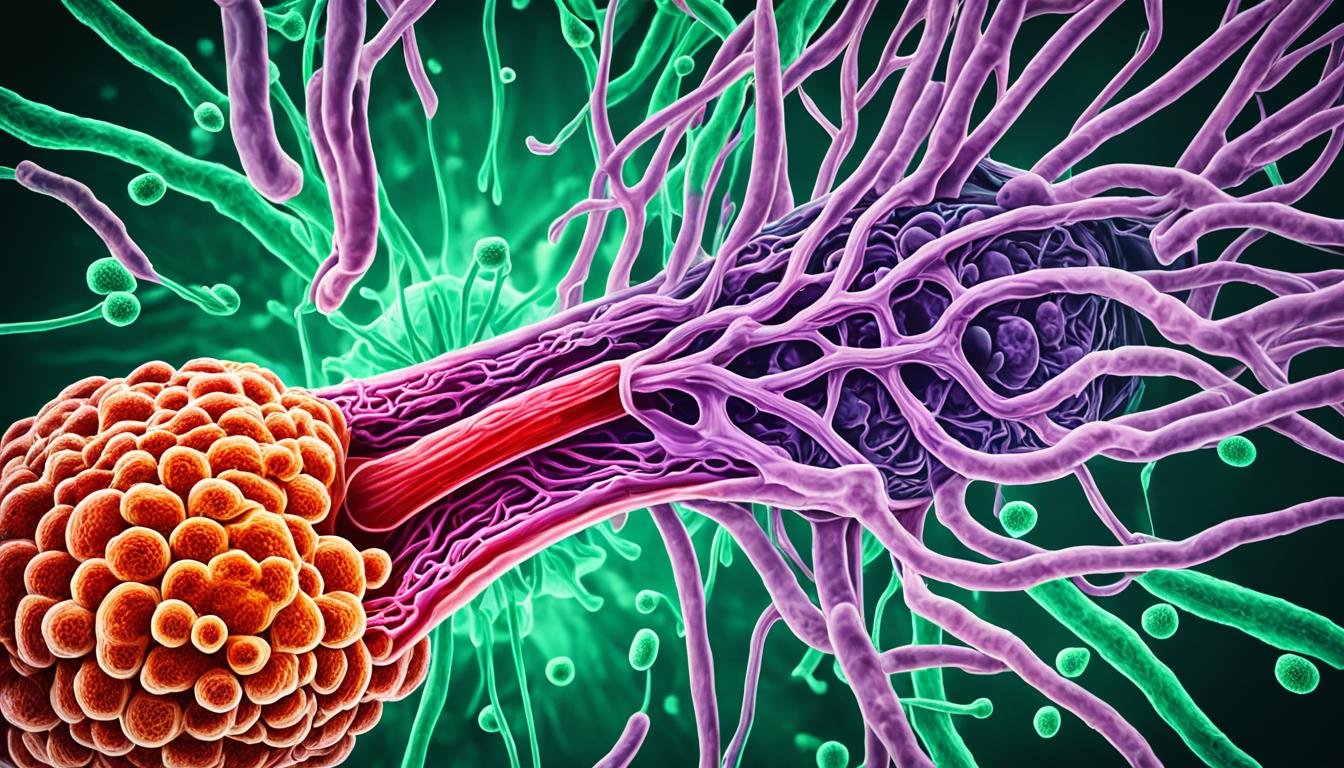Bile duct cancer is a quick-spreading, hard-to-fight cancer.1ok> It’s often found in later stages because it’s hard to spot early.1ok> The spread speed can change, but it’s usually fast.1ok> Survival chances depend a lot on when it’s found.
Bile duct cancer is both rare and moves fast.1ok> After surgery, the average time people live is 12.4 months.1ok> If you have certain risks, the spread might be quicker.
Key Takeaways
- Bile duct cancer is an aggressive form of cancer that can spread quickly.
- The average survival time after surgery for intrahepatic bile duct cancer is about 12.4 months.
- Bile duct cancer is a rare cancer, with approximately 8,000 cases diagnosed in the U.S. each year.
- Risk factors for bile duct cancer include primary sclerosing cholangitis, chronic ulcerative colitis, and liver or bile duct diseases.
- Survival rates for bile duct cancer are generally low, with a 5-year survival rate of just 9% overall.
What Is Bile Duct Cancer?
Bile duct cancer is a rare cancer type. It forms in the bile ducts.2 These are tiny tubes that move bile. Bile is a fluid made in the liver to help digest food.1 Bile ducts join the liver to the gallbladder or the small intestine.1 This kind of cancer is rare and grows quickly.
Definition of Bile Duct Cancer
Bile duct cancer is a tumor in the bile ducts. These tubes move bile from the liver to the intestine. It is also called cholangiocarcinoma.
Types of Bile Duct Cancer
There are three types of bile duct cancer. They are perihilar, distal, and intrahepatic. Perihilar cancer is at the start of the bile duct outside the liver. Distal cancer is closer to the small intestine, at the bottom of the bile duct. Intrahepatic cancer starts inside the liver.
How Fast Does Bile Duct Cancer Spread?
Aggressive Nature of Bile Duct Cancer
Bile duct cancer is not common but is very aggressive.1 Thanks to new treatments, there’s hope to live longer. Yet, it’s hard to spot early because it often shows no signs.3 These cancers can quickly break through the bile duct wall. Then, they can reach blood vessels and other organs easily.1 So, they spread faster than many other cancers.2 Doctors catch only a few cases before they spread further.
Factors Affecting Progression Rate
Several risk factors can change how fast bile duct cancer spreads.3 These include issues with the bile ducts, certain infections, and exposure to some chemicals. Family history also plays a part.3 This cancer can swiftly move to the liver, pancreas, or lymph nodes.3 The speed at which it spreads also hinges on where the tumor is, its stage, and type.3

Staging of Bile Duct Cancer
Bile duct cancer is split into stages to show if it has spread.4 This tells us how serious the cancer is and what treatments might work. The stages are from 0 to 4, and they change a bit based on the cancer type.
Stages of Intrahepatic Bile Duct Cancer
Intrahepatic bile duct cancer’s stages go from 0 to stage 4.5 The stages are different based on how far the cancer has spread. Stage 0 has cells that might turn into cancer.5 Stage I has small tumors while stage IV shows the cancer has spread far.5
Stages of Distal Bile Duct Cancer
Distal bile duct cancer also has stages from 0 to stage 4.5 Stage 0 means there are cells that could become cancer.5 Stage I has small tumor growth into the bile ducts.5 Stage III includes spread to lymph nodes or blood vessels.5
Stages of Perihilar Bile Duct Cancer
For perihilar bile duct cancer, the stages start at 0 for abnormal cells.5 They go up to stage IV if the cancer has spread outside the bile ducts.5
The staging system helps doctors know how to treat the cancer.6 Knowing the stage is key to discussing what to expect and planning treatment.6 Doctors use tests to determine the cancer’s stage.6
Metastasis: Where Does Bile Duct Cancer Spread?
Bile duct cancer can spread both nearby and to far-off places.7 It might go to the small intestine, liver, pancreas, or blood vessels close by.7 Also, it can spread to the lungs, brain, bones, and the belly lining commonly.7
Local Spread
When cancer spreads around the bile duct walls, it can get into the liver or fatty tissue.5 This makes it hard to fully remove it with surgery.7
Distant Metastasis
7 Bile duct cancer often spreads to the lungs, bones, abdomen lining, and brain. As it spreads, treating it becomes harder.
Symptoms of Bile Duct Cancer
If you have jaundice or feel pain in your belly, it might be time to see a doctor.2 Other signs include dark pee, itchy skin, and feeling sick. Weight loss is also a red flag.2 After checking your symptoms, the doctor may do tests to see what’s wrong.3
Cholangiocarcinoma, or bile duct cancer, is not common. It shows up with symptoms like jaundice or stomach upset. You might lose weight, feel less hungry, or get sick.3 Itchy skin and tiredness can also be signs. But, these warnings can be from other sicknesses too. This makes catching bile duct cancer early tough.
Bile duct cancer can move fast to big organs close by.3 If it’s not treated, it might go to your lungs or bones.3 So, it’s important to get checked early if you’re worried. Fast medical help is key for diagnosis and care.
Most people with bile duct cancer are 65 or older.8 It spreads fast in some but not in others.8 Keeping an eye on your health is crucial for everyone.
| Symptom | Description |
|---|---|
| Jaundice | Yellowing of the skin and whites of the eyes due to bile buildup in the body. |
| Abdominal Pain | Discomfort or pain in the upper abdomen, especially near the right side. |
| Dark Urine | Urine that appears dark yellow or brown in color. |
| Itchy Skin | Persistent and severe itching, often due to bile buildup under the skin. |
| Nausea and Vomiting | Feelings of sickness and inability to keep food down. |
| Weight Loss | Unintended and significant loss of body weight. |
Bad genes don’t usually lead to bile duct cancer.8 But, many people get gene changes over time.8 Surgery can help if the cancer is found early and not spread.8 Since there are no good tests for finding this cancer early, it’s vital to tell your doctor about any symptoms.8
Diagnosis of Bile Duct Cancer
Every year, about 8,000 people in the U.S. find out they have bile duct cancer.9 It is most common in people older than 65.9 Often, tumors are deep inside and can’t be felt by doctors right away.
People usually get diagnosed in their 70s, but younger ones can also get it.9 The risk goes up as you get older, with most cases found around 70-72 years old.9 Bile duct cancer is more common in Hispanic Americans.9
Things like ongoing inflammation and bile duct stones can up your risk for this cancer.9 Having it in the family, being overweight, drinking too much, and certain health issues can also make it more likely.9
Bile Duct Cancer: An Aggressive Malignancy
Bile duct cancer, or cholangiocarcinoma, is rare but very aggressive.1 It spreads fast to nearby parts, making it hard to treat.1 Sadly, doctors often find it late.2
This cancer spreads quickly because it can easily grow outside the bile duct.1 Then it gets to other organs through blood vessels.1 So, bile duct tumors often spread to places like the lungs.1
Bile duct cancer doesn’t show much signs early on.2 By the time it’s found, it’s usually already spread.2
This cancer is hard to beat, with a low 5-year survival rate.2 But, there’s hope with new drugs like durvalumab (Imfinzi).2 It might help improve survival for people with this cancer.2
How Fast Does Bile Duct Cancer Spread Compared to Other Cancers?
Bile duct cancer is more dangerous than pancreatic cancer, though it’s not as common.2 Pancreatic cancer ranks fourth in causing cancer deaths in the U.S. Bile duct cancer has a lower survival rate at 5 years.2
Bile duct cancer is rarer but often more aggressive.1 After surgery, those with intrahepatic bile duct cancer live about 12.4 months.1 Some risks can speed up its spread.1
Bile duct cancer is hard to find early because it shows few symptoms.10 It spreads fast, often to the liver, lymph nodes, and lungs.10
| Cancer Type | 5-Year Survival Rate |
|---|---|
| Pancreatic Cancer | About 11% |
| Bile Duct Cancer | About 9% |
Progression of Symptoms by Stage
In early stages of bile duct cancer, a person may not feel sick. They might have no symptoms. That is, until a tumor blocks a bile duct.5 As cancer advances to later stages, they might see symptoms. These could be jaundice, itchy skin, light stools, dark urine, stomach pain, and vomiting.5 More symptoms may appear as the cancer spreads to other body parts.
Doctors use five stages to group bile duct cancer. They look at the size of the tumor and if it has spread.2 These stages help track how severe the cancer is. They show the cancer’s growth speed and where it has spread.52
| Stage | Intrahepatic Bile Duct Cancer | Distal Bile Duct Cancer | Perihilar Bile Duct Cancer |
|---|---|---|---|
| 0 | Abnormal cells found in the innermost layer of tissue, not actual cancer, may spread into nearby tissue.5 | Abnormal cells found in tissue lining, not actual cancer, may spread.5 | Abnormal cells found in tissue lining, not actual cancer, may spread.5 |
| I | Divided into stages IA (tumor ≤ 5cm) and IB (tumor > 5cm).5 | Cancer formed and spread 1 | Cancer in tissue lining, spread into muscle or fibrous tissue layer.5 |
| II | Tumor has spread through the wall of the bile duct or multiple tumors have formed.5 | Divided into stages IIA (spread 1 | Cancer spread through wall to fatty tissue or liver tissue.5 |
| III | Divided into stages IIIA (spread through liver capsule) and IIIB (spread to nearby organs or lymph nodes).5 | Divided into stages IIIA (spread into bile duct wall and ≥ 4 lymph nodes) and IIIB (spread to large vessels and lymph nodes).5 | Divided into stages IIIA (spread to hepatic artery or portal vein branches), IIIB (spread to various bile duct parts), IIIC (spread to nearby lymph nodes).5 |
| IV | Cancer spread to other parts of the body such as bone, lungs, distant lymph nodes.5 | Cancer spread to other parts of the body like liver, lungs.5 | Divided into stages IVA (spread to ≥ 4 lymph nodes) and IVB (spread to other body parts).5 |
Higher stages of bile duct cancer mean worse symptoms and cholangiocarcinoma prognosis. Finding the cancer early and treating it fast are key to fighting against it.5
Treatment Options for Bile Duct Cancer
When you have bile duct cancer, your treatment changes based on the cancer’s stage and where it is. Your health also matters. The main way to treat early-stage cancer is by removing the bile ducts. But this can work for only a few people.11 You also have other options, like chemotherapy, radiation, targeted therapy, and immunotherapy.
Surgery
Doctors prefer to take out the cancer if it’s possible. This is usually the choice for cancers that are at stage 0, I, or II.11 They might use radiation or chemo with the surgery to help more.
Chemotherapy
Chemotherapy treats both early and later stages of cancer.12 For bile duct cancer, it often includes drugs like gemcitabine and cisplatin. Or it might be capecitabine and oxaliplatin (XELOX). Others are gemcitabine and oxaliplatin (GEMOX), and gemcitabine with capecitabine.12 Chemo can also ready you for surgery by slowing the cancer’s growth.
Radiation Therapy
Doctors might also use radiation to treat your cancer.11 It can work together with chemo or surgery. This helps control the cancer and, sometimes, its symptoms too.
Targeted Therapy
In some cases, doctors use special drugs like ivosidenib for treating bile duct cancer. These drugs are for cancer that has certain genetic changes.12
Immunotherapy
There are also new types of drugs that might help, like durvalumab and pembrolizumab.12 They boost your body’s defenses to fight the cancer.
If these treatments don’t fit you, there’s also the chance to try new therapies in research.1211 Joining a clinical trial gives you the newest therapies and supports research on this kind of cancer.
Survival Rates and Prognosis
The American Cancer Society gives us the rates for bile duct cancer survival. For those with local bile duct cancer, around 24% live for 5 more years. The number drops to 17% for local cancer that’s spread outside.
When it spreads nearby, survival is only 9% for the local kind and 16% for the other. For distant spread, only 2 out of 100 people make it. These numbers include both types of bile duct cancer.13
The general survival rate after 5 years is low, at 9% or 10%. This is for both types of cancer. So, these are the odds people face with bile duct cancer.13
Improving Outlook with New Treatments
But, there’s hope with new ways to find and treat this cancer. Thanks to new testing and treatments, things are looking up.14
Methods like chemo, radiation, and immunotherapy are working better. They might slow down the cancer or lessen its spread, even when it’s very bad.14
And some people do well with certain drugs during chemo. Between 15% and 50% see benefits from these drugs.14 While it’s still tough, there’s more hope today for those fighting this hard battle.
End-Stage Bile Duct Cancer
Bile duct cancer in stage 4 has spread a lot, often to the liver, lungs, and more.14 This makes it harder to treat, lowering life expectancy.14 The chance of curing it is very small, but doctors might treat it to help with symptoms. They do this to try and make life better.
Palliative Care
Palliative care is key for helping with the pain and other effects of bile duct cancer’s end stage.15 With the right pain medicine, pain can often be lessened.15 It’s very important to manage symptoms, like pain when moving.15 When cancer is very advanced, it can change the body’s chemical balance, sometimes leading to unconsciousness.
Clinical Trials
Joining in clinical trials might be a good choice for those in the final stage of bile duct cancer.2 New treatments like immunotherapy give hope.2 Also, the rate of death from cancer has been going down over the last 20 years. This shows we’re making progress.2
For stage 4 cancer, the outlook is not good. But, taking part in trials and getting good palliative care can improve life quality. It might also slow down the disease in some cases.14
Support Resources for Bile Duct Cancer Patients
Finding a group of people who understand can be a big help for those with bile duct cancer. The Cholangiocarcinoma Foundation is here, offering guidance, support, and a community. It’s a non-profit that helps people with this cancer.15
The PAN Foundation gives financial support for treatment costs, making it easier for patients.2 Also, for emotional support, the Cancer Support Helpline is available at 888-793-9355. They offer advice for anyone dealing with bile duct cancer.
This type of cancer can be really tough and feel very lonely. But, patients can find comfort in these support resources.15 Connecting with others who are going through the same thing can be very uplifting. They can share information, support, and help each other feel less alone.
Being part of a supportive community can make a big difference. It helps patients cope with their health challenges.15 It gives them hope and makes their daily life better.
Conclusion
Bile duct cancer is both rare and spreads fast.16 The chance of survival is small. Only 32.5% of people who have surgery survive 5 years or more.16 Yet, new treatments give hope. They are making things better for patients.17
If you have the signs, see a doctor at once. Working with your healthcare team is key. They help pick the best plan. It depends on how far the cancer has grown.
This type of cancer is very hard to beat. Fewer than 19.2% can be cured.16 But things are getting better. Tests and treatments have improved. The outlook is brighter for patients.17
Doctors study this cancer a lot. They share what they learn with each other. This helps them treat their patients better. Thanks to their hard work, more people might get well.17
Dealing with bile duct cancer is tough. But, don’t lose hope. Keep learning about it. And work as a team with your doctors. This can lead to the best results.1617
FAQ
What is bile duct cancer?
What are the types of bile duct cancer?
How fast does bile duct cancer spread?
What factors affect the progression rate of bile duct cancer?
What are the stages of bile duct cancer?
Where does bile duct cancer typically spread?
What are the symptoms of bile duct cancer?
How is bile duct cancer diagnosed?
How does bile duct cancer compare to other cancers in terms of aggressiveness?
What are the treatment options for bile duct cancer?
What are the survival rates for bile duct cancer?
What are the end-stage options for those with advanced bile duct cancer?
What support resources are available for bile duct cancer patients?
Source Links
- https://www.medicalnewstoday.com/articles/how-fast-does-bile-duct-cancer-spread
- https://www.healthline.com/health/cancer/how-aggressive-is-bile-duct-cancer
- https://birminghamhpbclinic.co.uk/how-fast-does-bile-duct-cancer-spread/
- https://www.cancerresearchuk.org/about-cancer/bile-duct-cancer/stages-grades/stages
- https://www.cancer.gov/types/liver/bile-duct-cancer/stages
- https://www.cancer.org/cancer/types/bile-duct-cancer/detection-diagnosis-staging/staging/staging-intrahepatic-bile-duct.html
- https://www.cancerresearchuk.org/about-cancer/bile-duct-cancer/about-advanced-bile-duct-cancer
- https://flcancer.com/articles/bile-duct-cancer/
- https://medschool.cuanschutz.edu/colorado-cancer-center/for-patients-families/cancers-we-treat/bile-duct-cancer
- https://www.massgeneralbrigham.org/en/about/newsroom/articles/gallbladder-and-bile-duct-cancer-diagnosis
- https://www.cancer.org/cancer/types/bile-duct-cancer/treating/based-on-situation.html
- https://www.cancer.gov/types/liver/bile-duct-cancer/treatment
- https://www.cancer.org/cancer/types/bile-duct-cancer/detection-diagnosis-staging/survival-by-stage.html
- https://www.medicalnewstoday.com/articles/stage-4-bile-duct-cancer-spread-to-liver-life-expectancy
- https://www.cancerresearchuk.org/about-cancer/bile-duct-cancer/living-with/advanced
- https://www.ncbi.nlm.nih.gov/pmc/articles/PMC1356849/
- https://www.ncbi.nlm.nih.gov/pmc/articles/PMC4146775/




